 | |
 A Cuban Foxtrot underway | |
| Class overview | |
|---|---|
| Builders | Sudomekh, Leningrad |
| Operators | |
| Preceded by | |
| Succeeded by | Tango-class submarine |
| Subclasses | |
| Built | 1957–1983 |
| In service | 1958–2014 |
| In commission | 1958–2014 |
| Completed | 75 |
| Lost | 1 |
| Preserved | 7 |
| General characteristics | |
| Type | Submarine |
| Displacement |
|
| Length | 89.9 m (294 ft 11 in) |
| Beam | 7.4 m (24 ft 3 in) |
| Draft | 5.9 m (19 ft 4 in) |
| Propulsion |
|
| Speed |
|
| Range |
|
| Endurance | 3-5 days submerged |
| Test depth | 246–296 m (807–971 ft) |
| Complement | 12 officers, 10 warrants, 56 seamen |
| Armament |
|
The Foxtrot class was the NATO reporting name of a class of diesel-electric patrol submarines that were built in the Soviet Union. The Soviet designation of this class was Project 641. The Foxtrot class was designed to replace the earlier Zulu class, which suffered from structural weaknesses and harmonic vibration problems that limited its operational depth and submerged speed. The first Foxtrot keel was laid down in 1957 and commissioned in 1958 and the last was completed in 1983. A total of 58 were built for the Soviet Navy at the Sudomekh division of the Admiralty Shipyard (now Admiralty Wharves), Saint Petersburg.[1] Additional hulls were built for other countries.
The Foxtrot class was comparable in performance and armament to most contemporary designs. However, its three screws made it noisier than most Western designs. Moreover, the Foxtrot class was one of the last designs introduced before the adoption of the teardrop hull, which offered much better underwater performance. Also, although the Foxtrot was larger than a Zulu class submarine, the Foxtrot class had 2 of its 3 decks dedicated to batteries. This gave it an underwater endurance of 10 days, but the weight of the batteries made the Foxtrot's average speed a slow 2 knots (3.7 km/h) at its maximum submerged time capability. Due to the batteries taking up 2 decks, onboard conditions were crowded, with space being relatively small even when compared to older submarines such as the much older American Balao-class submarine. The Foxtrot class was completely obsolete by the time the last submarine was launched. The Russian Navy retired its last Foxtrots between 1995 and 2000;[2] units were scrapped and disposed of for museum purposes.[3] During the division of the Soviet Black Sea Fleet, in 1997 one Foxtrot class submarine (later renamed as Zaporizhzhia) was passed to Ukraine as it was not operational since 1991. The ship never effectively served in the Ukrainian Navy and was under repair. In 2005 Ukrainian Ministry of Defence wanted to sell it, but was unsuccessful. Following successful post-repair trials in June 2013, it was recognised as operational.[4] However, on 22 March 2014 it was surrendered to or captured by Russia as part of the Russian annexation of Crimea.[5] Russia decided not to accept it due to its age and operational unsuitability. Its subsequent status is unknown.
Cuban Missile Crisis
Project 641s played a central role in some of the most dramatic incidents of the Cuban Missile Crisis. The Soviet Navy deployed four Project 641 submarines to Cuba. US Navy destroyers dropped practice depth charges near Project 641 subs near Cuba in efforts to force them to surface and be identified. Three of the four Project 641 submarines were forced to surface, one eluded US forces.[1]
Units
Following is a list of 58 of the 75[6] Foxtrot-class submarines built during the Soviet Project 641, at Yard 196, Leningrad.




| Number | Laid down | Launched | Decommissioned | Status |
|---|---|---|---|---|
| B-94 | 3 October 1957 | 28 December 1957 | 1 October 1984 | Decommissioned for scrapping[1] |
| B-95 | 2 February 1958 | 25 April 1958 | 22 February 1980 | Decommissioned for scrapping[1] |
| B-36 | 29 April 1958 | 31 August 1958 | 24 August 1993 | Decommissioned for scrapping[1] |
| B-37 | 18 July 1958 | 5 November 1958 | 11 January 1962 | Sank after fire and multiple explosions |
| B-133 | 27 September 1958 | 26 January 1959 | 1 October 1983 | Renamed B-833 |
| B-135 | 20 December 1958 | 30 March 1959 | 1 July 1977 | - |
| B-139 | 25 February 1959 | 30 May 1959 | 1 October 1976 | Renamed B-839 |
| B-116 | 9 June 1959 | 10 October 1959 | 28 September 1994 | - |
| B-130 | 22 August 1959 | 17 December 1959 | 1 October 1988 | - |
| B-85 | 23 December 1959 | 19 March 1960 | 19 April 1990 | - |
| B-59 | 21 February 1960 | 6 June 1960 | 19 April 1990 | - |
| B-156 | 20 April 1960 | 2 August 1960 | 19 April 1991 | - |
| B-153 | 6 August 1960 | 31 January 1961 | 24 June 1991 | Renamed B-854 |
| B-164 | 26 October 1960 | 2 August 1960 | 3 July 1992 | - |
| B-33 | 3 February 1961 | 27 April 1961 | 24 June 1991 | - |
| B-105 | 1 July 1961 | 1 October 1961 | 24 August 1993 | - |
| B-169 | 17 August 1961 | 29 November 1961 | 19 April 1990 | - |
| B-38 | 30 October 1961 | 31 January 1962 | 25 April 1989 | - |
| B-53 | 8 January 1962 | 12 April 1962 | 19 April 1990 | renamed B-853 |
| B-50 | 7 March 1962 | 15 June 1962 | 3 July 1992 | - |
| B-8 | 9 May 1962 | 21 July 1962 | 19 April 1990 | - |
| B-31 | 18 August 1962 | 3 November 1962 | 24 June 1991 | - |
| B-2 | 27 October 1962 | 25 January 1963 | 24 June 1991 | - |
| B-55 | 22 January 1963 | 5 April 1963 | 3 July 1992 | renamed B-855 |
| B-98 | 4 April 1963 | 15 June 1963 | 2001 | Renamed 292 Wilk |
| B-101 | 19 June 1963 | 30 August 1963 | 30 June 1993 | - |
| B-6 | 9 August 1963 | 30 November 1963 | 24 August 1994 | - |
| B-103 | 14 December 1963 | 16 April 1964 | 24 June 1991 | - |
| B-109 | 22 February 1964 | 17 June 1964 | 28 September 1997 | - |
| B-107 | 18 April 1964 | 25 July 1964 | 4 August 1995 | renamed B-807 |
| B-112 | 19 June 1964 | 27 October 1964 | 19 April 1990 | - |
| B-25 | 26 August 1964 | 22 December 1964 | 3 July 1992 | - |
| B-205 | 17 June 1969 | 29 August 1969 | 31 January 1996 | - |
| B-143 | 21 October 1959 | 17 February 1960 | 24 June 1991 | |
| B-15 | 10 October 1963 | 21 February 1964 | 29 October 1992 | - |
| B-427 | 10 April 1971 | 22 June 1971 | 28 April 1994 | Formerly a Museum, Long Beach, California, USA |
| B-39 | 9 February 1967 | 15 April 1967 | 5 July 1994 | Formerly a Museum, San Diego, California, USA
Sold for scrap 2022 |
| B-440 | 1 June 1970 | 16 September 1970 | 1999 | Museum, Vytegra, Russia |
| B-435 | 24 March 1970 | 29 May 1970 | Unknown | As U-01 "Zaporizhiya" in Ukraine |
| B-9 | 26 December 1964 | 31 March 1965 | 17 July 1997 | - |
| B-4 | 14 June 1960 | 3 October 1960 | 24 June 1991 | - |
| B-57 | 23 April 1959 | 15 August 1959 | 24 June 1991 | - |
| B-7 | 14 April 1961 | 29 June 1961 | 19 April 1990 | - |
| B-21 | 29 October 1964 | 16 February 1965 | 3 July 1995 | ex-Seafront Zeebrugge Museum, Belgium. 2019 towed away for scrapping in Ghent. |
| B-26 | 6 May 1965 | 10 August 1965 | 24 June 1991 | - |
| B-28 | 24 May 1965 | 10 August 1965 | 30 June 1993 | - |
| B-34 | 13 August 1965 | 16 November 1965 | 24 June 1991 | - |
| B-40 | 24 September 1965 | 16 November 1965 | 30 June 1993 | - |
| B-29 | 25 March 1966 | 20 May 1966 | 2003 | 1988 Renamed 293 Dzik |
| B-41 | 7 April 1966 | 20 May 1966 | 24 August 1993 | - |
| B-46 | 13 August 1966 | 24 December 1966 | 30 June 1993 | - |
| B-49 | 12 October 1966 | 24 December 1966 | 31 December 1993 | As "Foxtrot B-39 U-475 Black Widow", former museum awaiting restoration on the River Medway near Rochester, Kent, England |
| B-397 | 7 May 1967 | 22 August 1967 | 30 June 1993 | - |
| B-400 | 29 May 1967 | 22 August 1967 | 24 September 1991 | - |
| B-413 | 28 June 1968 | 7 October 1968 | 1999 | Museum, Kaliningrad, Russia |
| B-416 | 18 July 1968 | 25 February 1969 | 3 July 1992 | - |
| B-213 | 1 October 1969 | 20 January 1970 | 30 June 1993 | - |
| B-409 | 18 December 1970 | 2 March 1971 | 30 June 1993 | - |
Operators
Most saw service in the Soviet Navy. Foxtrots were also built for the Indian Navy (eight units, from 1967 to 1974), Libyan (six units, from 1978 to 1980), and Cuban (six units, from 1978 to 1983) navies. Some Soviet Foxtrots later saw service in the Polish and Ukrainian navies.
- Soviet Navy (passed on to successor states)
- Russian navy (ex–Soviet Navy)
- Indian Navy Variants known as the Kalvari class, and Vela class, now decommissioned (INS Kursura converted into a museum)[8]
- Libyan Navy 6 units (2 left but probably abandoned)[9]
- Cuban Navy three units (hull numbers 309, 510 and 586, incidentally this one was the last "Foxtrot" built)
- Polish Navy 2 units (ex–Soviet Navy)
 A Libyan foxtrot
A Libyan foxtrot - Ukrainian Navy 1 unit (Zaporizhzhia), has been taken over by Russian forces during the 2014 Crimean crisis.
On display
Several Foxtrots are on display as museums around the world, including:
- B-413 at Kaliningrad, Russia.
- B-427 at the RMS Queen Mary in Long Beach, California, United States.
- B-440 at Vytegra, a port on the Volga–Baltic Waterway in Russia.[10]
- U-475 Black Widow at Strood, Kent, United Kingdom
- Indian Foxtrot submarine INS Kursura (S20) at the Rama Krishna Beach, Visakhapatnam, India.
- A Libyan Foxtrot submarine is docked in Benghazi, Libya.
Citations
- 1 2 3 4 5 Korabli VMF SSSR, Vol. 1, Part 2, Yu. Apalkov, Sankt Peterburg, 2003, ISBN 5-8172-0072-4
- ↑ "Russian Navy". Fas.org. 2008-05-30. Archived from the original on 2015-04-08. Retrieved 2011-12-29.
- ↑ "Подводные лодки. Проект 641".
- ↑ In Sevastopol celebrated the anniversary of including the great submarine "Zaporizhia" to the fleet as combat ready (У Севастополі відзначили річницю прийняття великого підводного човна “Запоріжжя” до бойового складу флоту). Ministry of Defence of Ukraine. 21 January 2013
- ↑ "Ukrainian Sailors Surrender Submarine to Russian Navy". NBC News. 22 March 2014.
- ↑ Cold War Submarines, Polmar & Moore, Brassey's Inc., Washington, D.C. 2004; Podvodnye Lodki Kholodnoy Voyny, OAO SPMBM Malakhit, Sankt Peterburg, 2011
- ↑ All photos taken inside museum ship acknowledged to User:Mario52
- ↑ Navy decommissions last Kalvari-class submarine INS Vagli
- ↑ "Submarine forces (Libya), Submarines - Submarine forces". Janes. Nov 10, 2010. Retrieved 11 March 2011.
- ↑ Подводная лодка Б-440 (Submarine B-444) (in Russian)
References
- Miller, David (2002). The Illustrated Directory of Submarines of the World. London: Salamander Books. ISBN 1-84065-375-2.
- А.Б. Широкорад: Советские подводные лодки послевоенной постройки (A.B. Shirokorad: Sowjet Submarines built after WWII) Moscow, 1997, ISBN 5-85139-019-0 (Russian)
- Y. Apalkow: Корабли ВМФ СССР. Многоцелевые ПЛ и ПЛ спецназначания ("Ships of the USSR - Multi-purpose submarines and Special submarines"), St Petersburg, 2003, ISBN 5-8172-0069-4 (Russian)
External links
- https://fas.org/man/dod-101/sys/ship/row/rus/641.htm Archived 2016-03-06 at the Wayback Machine
- https://fas.org/man/dod-101/sys/ship/row/rus/index.html Archived 2015-04-08 at the Wayback Machine
- HNSA Ship Page: Soviet B-413
- Foxtrot Class Submarines - Complete Ship List (English)
- Project 641 at deepstorm.ru (Russian)
- Photos and history of the submarine Foxtrot in Rochester UK
